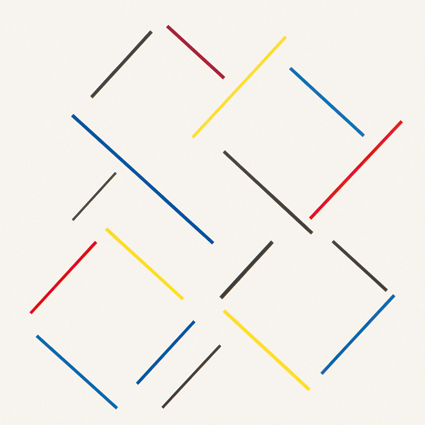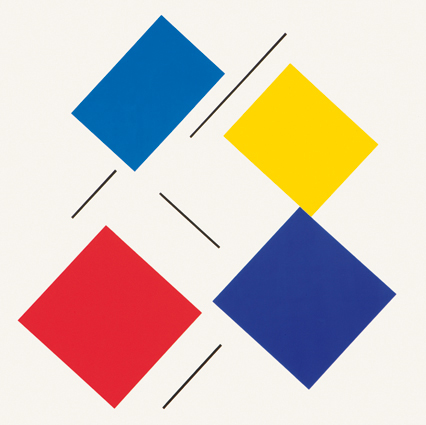Geneviève Claisse
Roche corneille (transparence / plénitude), 1995
[Craw Rock (transparency / fullness)]
Acrylic on canvas
2 parts
Each 100 x 100 cm
© VG Bild-Kunst, Bonn 2022
Photos: Franz Wamhof
Immediately on first sight one sees that the two paintings of Roche corneille [Craw Rock] with the subtitles transparency and fullness are closely related. The one seems to be a variation on the other, and the differences between the two are balanced out by the correspondences. Both are based on a diagonal arrangement of rectangles and lines in the form of slender rectangles in the basic colours yellow, red and blue and black. Our eye wanders back and forth between the two so as to perceive the fullness in the one and the transparency in the other. Although the diagonals actually serve to create the dynamism in the paintings, both works, alone and together seem extremely harmonious and balanced. Every weighting is balanced out by another, so that the painting of fullness is not full, just as that of transparency is not empty. The two augment one another on an ideal level and reveal an artistic hand that has mastered the principles of formal composition throughout years of practice.
Geneviève Claisse is an artist who has never seen any alternative to non-objective art. Already her first artistic assays were abstract and influenced by the writings of Kandinsky and Auguste Herbin, one of the founding fathers of French Constructivism. She was to become his assistant and later administered his estate. It is against this intellectual backdrop that one must view Claisse’s work. Both Kandinsky as well as Herbin believed art to be a universal language that was not simply unique, but also independent of every other form of human expression. Moreover they believed that it could commune its content to the mind purely via form and colour – just as soon as one had finally understood its laws. Herbin even developed a dedicated constructivist alphabet for his art. Although no immediate traces of this literally understood utopia of a universal art language are to be found in Claisse’s work, it is based on the firm conviction that art is a medium that creates its very own content, one that no other medium can capture, regardless of whether music or language or any other. To her mind art constitutes the ineffable and indemonstrable. Seen in this light, the subtitles to the Roche corneille paintings should not be regarded as explanations or the subject of the works, but simply as hints for a way of seeing that takes in the content of the two paintings solely by means of perception – without words. (Andreas Pinczewski)



